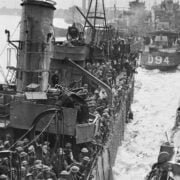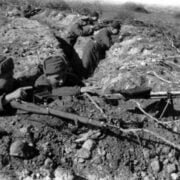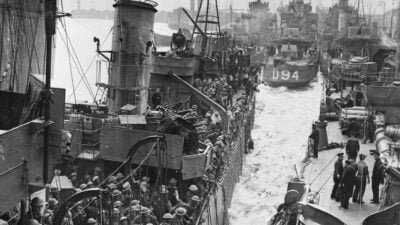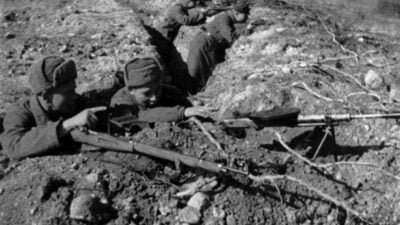The Korean War, a period fought between 1950 and 1953, was a complex conflict involving local and international forces, leaving an indelible mark on the history of the Korean Peninsula. To understand the origins of this bloody conflict, it is crucial to explore the post-World War II geopolitical context.
Also check out: The Complex Trajectory of the South Korean War
Background in the Korean War Period
The division of Korea along the 38th parallel after World War II laid the groundwork for the conflict that would unfold in the 1950s. This ideological demarcation, with the North aligned with Soviet influence and the South under American aegis, reflected the geopolitical tensions of the Cold War.


Division of Korea and International Influence
The dividing line was not just geographical; it was an ideological chasm. In the North, the seeds of communism planted by the Soviet Union found fertile ground, giving rise to a regime led by Kim Il-sung. Meanwhile, in the South, a democracy backed by the United States emerged, led by Syngman Rhee.
Foreign Interests
The direct influence of superpowers, the United States and the Soviet Union, was evident in how they shaped the destiny of Korea. The global rivalry between these powers played a crucial role in perpetuating the division, with the peninsula becoming a symbolic battleground of the Cold War.
The remnants of Japanese rule also echoed in the Korean division. The Japanese occupation during World War II left deep scars, influencing perceptions and relations between the Koreas. The Japanese withdrawal opened the door to foreign intervention, contributing to the complexity of the situation.
The division was not just a line on the map; it was a geopolitical time bomb. The instability in the region was palpable, with both sides amassing military arsenals and fueling tensions that would eventually result in the armed conflict that marked this war.
North Korean Invasion
North Korean leader Kim Il-sung, guided by his communist aspirations, saw the invasion as an opportunity to unify Korea under the red banner of communism. The geopolitical context of the Cold War stimulated this ambition, making the peninsula an ideological battleground between superpowers.
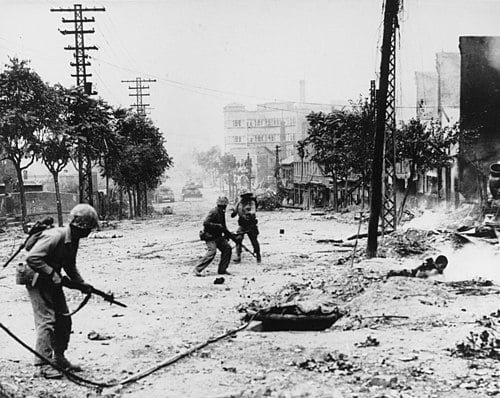

Quest for Unification Under the Communist Banner
The North Korean invasion did not go unnoticed by the international community. The UN, in a swift and determined response, mobilized an international coalition led by the United States to contain communist expansion on the peninsula. This action highlighted the global nature of the conflict and the strategic importance of the region.
Challenges for South Korean and UN Forces
The well-trained and equipped North Korean forces swiftly advanced through South Korean territory, surprising South Korean and UN forces. The initial superiority of the North increased the urgency of the international response, leading to a series of crucial battles that would shape the early stages of the conflict.
The Battle of Pusan emerged as a significant turning point. Allied forces, under the command of General MacArthur, managed to halt the North Korean advance, reversing the tide of the conflict. This battle underscored the importance of international coordination and effective military strategies in resisting the invasion.
Use of Guerrilla and Surprise Tactics in the Korean War Period
During the invasion, North Korean forces adopted innovative tactics, including guerrilla warfare and surprise attacks. These strategies challenged the Organization’s and South Korea’s forces, intensifying the complexity of the conflict and demonstrating the continuous adaptation of military tactics on the Korean battlefield.
Beyond the physical effects of the conflict, the North’s surprising aggression created a sense of urgency and solidarity among allied nations, fueling a commitment to defend democratic principles on the Korean Peninsula.
UN Intervention and Involvement of Key Countries
Faced with an imminent threat to stability in the region, the Organization acted swiftly, mobilizing an international coalition to confront the North Korean aggression. Member countries, aware of the strategic importance of the peninsula, contributed troops, resources, and logistical support to strengthen resistance against the invasion.


Global Cooperation Against Aggression
The United States played a central role in the international response, leading United Nations operations and providing a substantial number of troops. This leadership highlighted the American commitment to defending democratic principles in South Korea, solidifying its position as a key actor in the conflict.
In addition to the United States, countries like the United Kingdom, Australia, and Canada made significant contributions to UN forces. Their well-trained and disciplined troops played a crucial role in the ensuing battles, demonstrating the truly international nature of the Korean conflict.
The diversity of troops and strategies among allied countries presented significant challenges in the effective coordination of military operations. The need to integrate different approaches and military cultures tested the coalition’s collaboration capabilities, highlighting the complexity of uniting diverse nations in a common effort.
Integrated Command and Communication Challenges
To overcome coordination challenges, an integrated command was established under the UN flag. However, communication difficulties and cultural differences among allied troops required significant efforts to ensure effective cooperation on the Korean battlefield.
The UN’s intervention in the war not only reflected an immediate response to North Korean aggression but also had long-term implications on the international stage. It set a precedent for the organization’s involvement in regional conflicts, emphasizing the importance of global cooperation in maintaining peace and security.
Battles and Military Strategies during the Korean War Period
The Battle of Inchon, led by General MacArthur in September 1950, stood out as a strategic turning point. The successful landing of allied forces behind enemy lines broke the North Korean offensive and turned the course of the conflict, demonstrating the effectiveness of bold strategies.
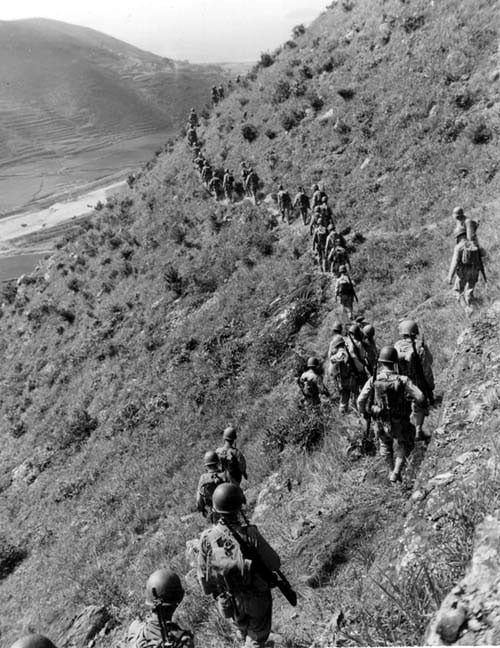

Battle of Inchon: The Strategic Turning Point
The massive entry of Chinese troops into the Battle of the Yalu River in October 1950 introduced a new dynamic to the conflict. UN forces, initially in the advantage, were confronted with formidable opposition, turning the war into a prolonged and bloody struggle.
Trench Warfare: Stagnation and Defensive Strategies
As the war progressed, the front lines stabilized, giving rise to trench warfare. Defensive strategies became predominant, resulting in prolonged and violent battles reminiscent of World War I, with both sides fighting for minimal gains.
The Battle of Chosin Reservoir in December 1950 was marked by adverse weather conditions and intense siege. UN forces faced extreme temperatures while repelling North Korean and Chinese attacks, demonstrating resilience and tenacity in the face of adversity.
The Battle of Heartbreak Ridge in 1951 was an example of the constant struggle in the Korean mountains. Both sides sought strategic gains in elevated terrain, resulting in prolonged and costly clashes that illustrated the relentless nature of attrition warfare.
Technological Innovations in the Korean War Period
The war witnessed the extensive use of artillery and aviation by both parties. Technological advancements were incorporated into military tactics, with bombings and air attacks playing a crucial role in the conflict’s dynamics, adding a modern dimension to attrition warfare.
In addition to physical battles, the attrition war in Korea included psychological warfare strategies. Both sides sought to undermine the morale and determination of the enemy, using psychological tactics to wear down opponents and maintain a psychological advantage throughout the prolonged conflict.
Chinese Intervention in the Korean War Period
Chinese intervention was motivated by regional security concerns and ideological alignment. The proximity of North Korea to the Chinese border raised fears of Western military presence on its borders, while ideological affinity with North Korean communism reinforced China’s commitment to intervention.


Motivations for Intervention
The entry of Chinese troops into the conflict was marked by a massive and surprising offensive. Sino-North Korean combined forces launched vigorous attacks on UN and South Korean positions, resulting in significant setbacks for the allied forces.
Retreat of Allied Forces
Chinese intervention drastically altered the dynamics of the conflict. UN forces, previously advancing toward the Sino-Korean border, were forced to retreat. China’s strategic skill and military strength surprised allied forces, marking a turning point in the war.
The Battle of Chosin Reservoir, which had already been a milestone in the war, now took on a new dimension with the massive presence of Chinese troops. China’s direct involvement intensified the siege, further testing the resilience of allied forces in adverse conditions.
Chinese intervention led to prolonged stagnation in the conflict. The need for diplomatic negotiations became evident, as the continuation of hostilities would result in unsustainable human and material costs. The global political landscape also pressed for a peaceful resolution.
Panmunjom and the Armistice Line
Panmunjom, the village that served as a meeting point for negotiations, became a symbol of the quest for peace on the Korean Peninsula. Located in the Demilitarized Zone, the neutral area witnessed intense discussions between delegations from the conflicting parties, representing the hope for an agreement that would end the bloodshed.
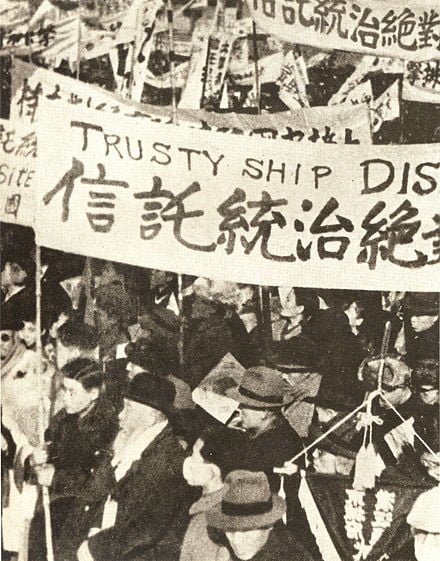

Meeting Point in Panmunjom
Negotiations in Panmunjom were complex, marked by significant challenges in seeking consensus. Ideological and strategic differences between the parties made the process difficult, requiring diplomatic skill to overcome obstacles and find common ground that allowed the establishment of an armistice.
Strategic Importance of the Armistice Line in the Korean War Period
The signing of the armistice in July 1953 resulted in the creation of the Armistice Line, dividing the peninsula along the 38th parallel. While this line brought a pause to hostilities, it also established a lasting division between the Koreas, shaping the course of inter-Korean relations to this day.
The Demilitarized Zone, created as part of the agreement, became a fragile border marked by constant tension between the Koreas. Despite its name, the military presence near the Armistice Line highlighted the persistence of latent hostilities, reflecting the delicate nature of the ceasefire agreement.
The armistice had significant implications for international relations. The superpowers involved in the Korean War, especially the United States and the Soviet Union, indirectly shaped the balance of power in the region through this agreement.
Human and Economic Impacts
The conflict resulted in immeasurable human devastation. Millions of lives were lost, both among military forces and the civilian population. Families were torn apart, entire communities decimated, leaving a legacy of pain and loss that echoes through generations.
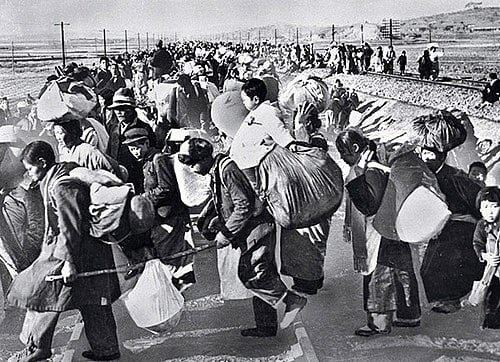

Loss of Lives and Unfathomable Suffering during the Korean War Period
O deslocamento em massa foi uma consequência direta da guerra, com milhares de coreanos fugindo dos horrores do conflito. A desintegração social decorrente do deslocamento gerou desafios adicionais, afetando a coesão das comunidades e contribuindo para a formação de uma diáspora coreana em diferentes partes do mundo.
Destroyed Infrastructure
The infrastructure of the Korean Peninsula was extensively destroyed during the years of combat. Roads, bridges, cities, and industrial facilities were reduced to rubble, negatively impacting the economic capacity of the region. Reconstruction would be a Herculean task, laying the foundation for enduring economic challenges.
The prolonged economic cost of the War reverberated for decades. The need to rebuild damaged infrastructure, along with the burden of military expenditures, strained the economies of both North and South Korea. Challenges in economic recovery and development were exacerbated by the persistent ideological division.
Impacts of the Korean War Period on Current Disparities
The war contributed to the economic divisions that persist to this day. While South Korea emerged as a regional economic powerhouse, driven by industrialization and modernization policies, North Korea faced persistent challenges, including international isolation and centralized economic policies.
The legacy of the human and economic impacts of the Korean War, a period of great destruction, is passed down to future generations. The emotional and economic scars shaped the mindset of Korean societies, but also demonstrated remarkable resilience in the face of adversity, reflected in the ongoing pursuit of development and overcoming disparities.







